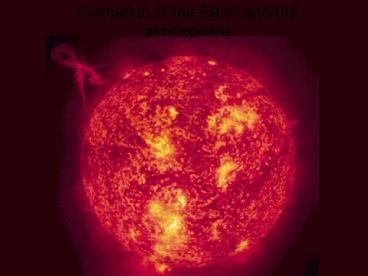Formation of the Earth and the atmosphere - PowerPoint PPT Presentation
1 / 36
Title:
Formation of the Earth and the atmosphere
Description:
http://nssdc.gsfc.nasa.gov/imgcat/hires/nea_0127504836_mos.jpg. PLANETARY. EVOLUTION ... Average distance from Earth to the Sun is 150,000,000 km (93,000,000 mi) ... – PowerPoint PPT presentation
Number of Views:169
Avg rating:3.0/5.0
Title: Formation of the Earth and the atmosphere
1
Formation of the Earth and the atmosphere
2
Solar System Formation and Structure
- Gravity
- Mutual attracting force exerted by mass on all
other objects - Planetesimal hypothesis
- Suns condense from nebular clouds
3
(No Transcript)
4
PLANETARY EVOLUTION
5
Eros. Taken by NEAR http//nssdc.gsfc.nasa.gov/img
cat/hires/nea_0127504836_mos.jpg
6
PLANETARY EVOLUTION
7
(No Transcript)
8
Our Solar System
Figure 2.1
9
Dimensions and distances
- Earths orbit
- Average distance from Earth to the Sun is
150,000,000 km (93,000,000 mi) - Perihelion closest at January 3
- 147,255,000 km (91,500,000 mi)
- Aphelion farthest at July 4
- 152,083,000 km (94,500,000 mi)
- Plane of Earths orbit is the plane of the
ecliptic
10
- Perihelion closest at January 3
- 147,255,000 km (91,500,000 mi)
- Aphelion farthest at July 4
- 152,083,000 km (94,500,000 mi)
11
Milankovitch Cycles
- Ellipticity of the orbit
- 100,000 year cycle
12
- Precession
- The earths wobble
- 26,000 year cycle
13
- Axial tilt
- 40,000 year cycle
14
Solar Energy From Sun to Earth
- Solar Activity and Solar Wind
- Electromagnetic Spectrum of Radiant Energy
- Intercepted Energy at the Top of the Atmosphere
15
Solar Activity and Solar Wind
- Solar wind is clouds of electrically charged
particles - Sunspots are caused by magnetic storms
- Sunspots have activity cycle of 11 years
Figure 2.2
16
The Electromagnetic Spectrum
- Sun radiates shortwave energy
- Shorter wavelengths have higher energy
- Earth radiates longwave energy
Figure 2.5
Figure 2.6
17
Earths Energy Budget
Figure 2.8
18
Solar and Terrestrial Energy
Figure 2.7
19
- Tropics receive more concentrated insolation
(2.5x more) than the poles due to the Earths
curvature
Figure 2.9
20
The Seasons
- Seasonality
- Reasons for Seasons
- Annual March of the Seasons
- What seasonal changes in the sun do we observe?
21
Suns Altitude
22
Tilt of the earths axis
SUN
Memphis
Equator
23
Suns altitude
24
Suns Altitude
Winter
Summer
25
Suns Altitude
Winter
Summer
26
Declination latitude where the sun is directly
overhead.
Winter
Summer
Tropic of Cancer
Tropic of Capricorn
27
Seasonality
- Seasonal changes
- Suns altitude angle above horizon
- Declination location of the subsolar point
- Daylength
28
Reasons for Seasons
- Revolution
- Earth revolves around the Sun
- Voyage takes one year
- Earths speed is 107,280 kmph (66,660 mph)
- Rotation
- Earth rotates on its axis once every 24 hours
- Rotational velocity at equator is 1674 kmph (1041
mph)
29
Revolution and Rotation
Figure 2.13
30
Reasons for Seasons
- Tilt of Earths axis
- Axis is tilted 23.5 from plane of ecliptic
- Axial parallelism
- Axis maintains alignment during orbit around the
Sun - North pole points toward the North Star (Polaris)
31
Axial Tilt and Parallelism
Figure 2.14
32
Solstice when the sun is at its maximum north
or south.
Winter
Summer
Tropic of Capricorn
Tropic of Cancer
Summer solstice June 20 or 21 Subsolar point
Tropic of Cancer
Winter solstice December 21 or 22 Subsolar
point Tropic of Capricorn
33
Equinox when the sun passes over the equator
34
Annual March of the Seasons
- Winter solstice December 21 or 22
- Subsolar point Tropic of Capricorn
- Spring equinox March 20 or 21
- Subsolar point Equator
- Summer solstice June 20 or 21
- Subsolar point Tropic of Cancer
- Fall equinox September 22 or 23
- Subsolar point Equator
35
Annual March of the Seasons
Figure 2.15
36
The sun
- Termperature of the surface 6000 oC































